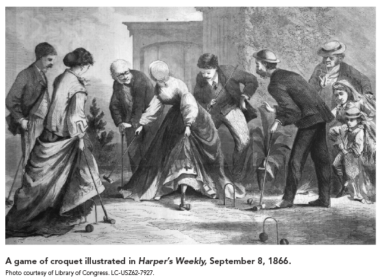The Nineteenth-Century Croquet Craze
This is an excerpt from Sport in America, Volume II by David K Wiggins.
Croquet is usually stereotyped as a genteel game, less a sport than a social function, and more suited to genial conversation and unfettered flirtation than strident competition. Nineteenth- century American periodicals and croquet manuals emphasized the sport's placidity, as opposed to male working-class sports such as football, baseball, and rowing, which often seemed infected with the time-discipline or rationality of the workaday world. The Newport (Rhode Island) Croquet Club's 1865 handbook proclaimed that the game owed its popularity to “the delights of out-of-doors exercise and social enjoyment, fresh air and friendship—two things which are of all others most effective for promoting happiness.” Croquet was portrayed as a morally improving and rational recreation; the New York Galaxy declared that “amiability and unselfishness are the first requisites of a good player.” Because croquet was not a particularly athletic game, it was considered ideal for children, older people, and mixed gender groupings. Thus, one recent historian of the sport decisively concluded, “In the 1860s, in a family and female sport like croquet, the etiquette of playing the game with grace and good manners took precedence over winning, sociable play triumphed over unprincipled competition.”
Yet was this, in fact, how the game was played on the croquet lawns of the nineteenth century? While authors of croquet manuals and magazines propounded trite encomiums to honesty, rationality, and fellowship, a perusal of visual and literary evidence reveals that a great deal of competitive spirit existed in the typical croquet match, that the use of deception to win was common, and that women were particularly guilty transgressors. Modern reliance on croquet manuals and a handful of periodical articles recalls the limitations of other nineteenth-century hortatory literature such as etiquette and advice manuals; that is, the ethos was only a code, not an accurate depiction of reality. Female grace and good manners may have been the ideal for the rule- and taste-makers, but on the croquet ground, a peculiar sort of gender reversal enabled women to temporarily jettison their passive role and dominate, if not humiliate, men. Women played the game seriously, enjoyed matching skills with men, and often emerged victorious. The fact that this image runs contrary to “Victorian” gender stereotypes suggests that a more nuanced approach is needed, rather than to declare some sports to be “male” and other sports “female” with all the formulaic and oversimplified preconceptions these adjectives imply.

SHOP

Get the latest insights with regular newsletters, plus periodic product information and special insider offers.
JOIN NOW


